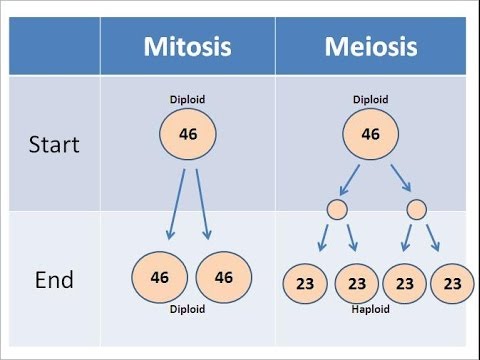3.6: Compare and Contrast Mitosis and Meiosis
- Page ID
- 132157
3.6 Compare and Contrast Mitosis and Meiosis
Here, we outline the differences between mitosis and meiosis in humans (Diploid #46). Knowing the differences between these fundamental cell processes is an important foundation in your understanding of genetics for the rest of the course.
| Cell Processes | Mitosis | Meiosis |
|---|---|---|
| Creates | all the cells in your body except sex cells | sex cells only; Female egg cells or Male sperm cells |
| Definition
|
process of cell division that forms two new cells (daughter cells), each of which has the same number of chromosomes | process in cell division during which four new cells are created each with half the original number of chromosomes, which results in the production of sex cells |
| End Products | 2 daughter cells | 4 daughter cells |
| Steps | Interphase, Prophase, Metaphase, Anaphase, Telophase | Interphase, Prophase I, Metaphase I, Anaphase I, Telophase I, Prophase II, Metaphase II, Anaphase II, Telophase II |
| Type of Reproduction | asexual | sexual |
| Are they identical to the parent cell? |
Yes, they are identical |
No, they are different since they have half the number of chromosomes as the original |
| When does cytokinesis occur? | occurs in Telophase | occurs in Telophase I, and Telophase II |
|
How many times does the parent cell divide? |
1 | 2 |
|
What happens to the number of chromosomes at the end of each process? Are they in pairs or individual chromosomes? |
Identical to parent; Individual chromosomes |
½ chromosomes as parent; individual chromosomes |
| Why is each important? | Needed to repair damaged body, create new body cells, for growth, and to replace cells that have died | Needed to create sex cells required for sexual reproduction to create a new organism, and for variation within a population |
|
How many chromosomes do human body cells and human sex cells have after they go through each process? |
46 | 23 |
Take a look at the following video, Mitosis vs. Meiosis, by Beverly Biology (2014) on YouTube, which compares and contrasts mitosis and meiosis.
Reference
Beverly Biology. (2014, May 3). Mitosis vs. Meiosis (video file). YouTube. https://www.youtube.com/watch?v=bRcjB11hDCU



